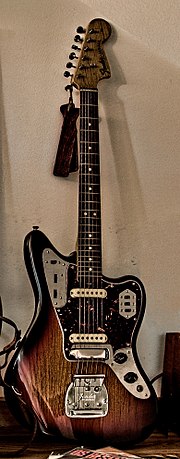| Fender Jaguar | |
|---|---|
 | |
| Manufacturer | Fender |
| Period | 1962–1975; 1999–present |
| Construction | |
| Body type | Solid |
| Neck joint | Bolt-on |
| Scale | 24 inches (609.6 mm) |
| Woods | |
| Body | Alder, basswood |
| Neck | Maple |
| Fretboard | Rosewood, pau ferro, maple, ebony, Indian Laurel |
| Hardware | |
| Bridge | "Floating" proprietary vibrato unit Tune-o-matic |
| Pickup(s) | Standard models include two single-coils; variants may include two humbuckers or 1 single-coil and 1 humbucker |
| Colors available | |
| Various 2- or 3-color sunbursts Various shades of white, blue, red, green, etc. | |
The Fender Jaguar is an electric guitar by Fender Musical Instruments characterized by an offset-waist body, a relatively unusual switching system with two separate circuits for lead and rhythm, and a short-scale 24" neck. Owing some roots to the Jazzmaster, it was introduced in 1962 as Fender's feature-laden top-of-the-line model, designed to lure players from Gibson. During its initial 13-year production run, the Jaguar did not sell as well as the less expensive Stratocaster and Telecaster, and achieved its most noticeable popularity in the surf music scene. After the Jaguar was taken out of production in 1975, vintage Jaguars became popular first with American punk rock players, and then more so during the alternative rock, shoegazing and indie rock movements of the 1980s and 1990s. Fender began making a version in Japan in the mid-1980s, and then introduced a USA-made reissue in 1999. Since then, Fender has made a variety of Jaguars in America, Mexico, Indonesia and China under both the Fender and Squier labels. Original vintage Jaguars sell for many times their original price.